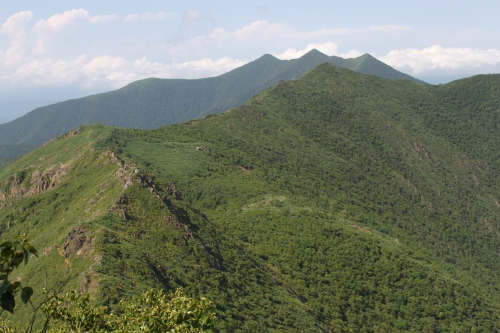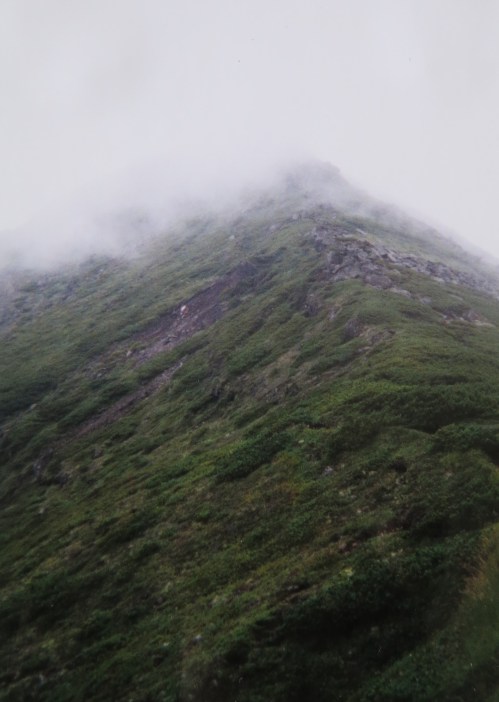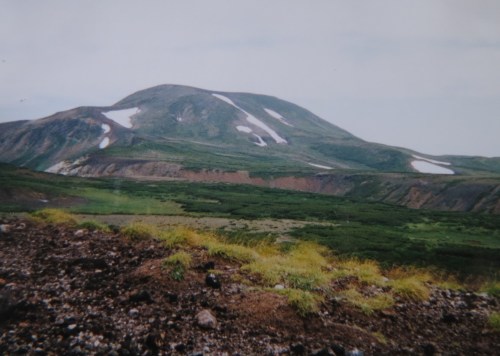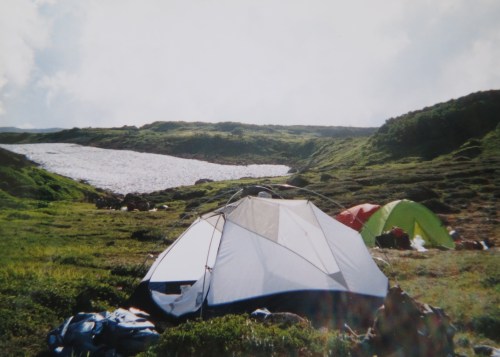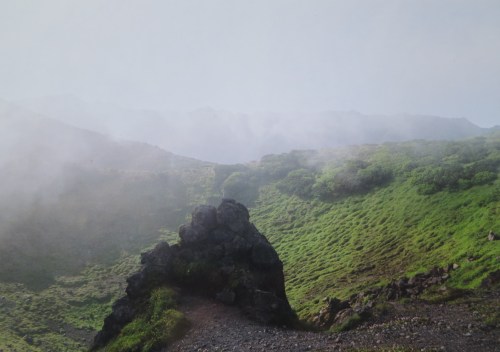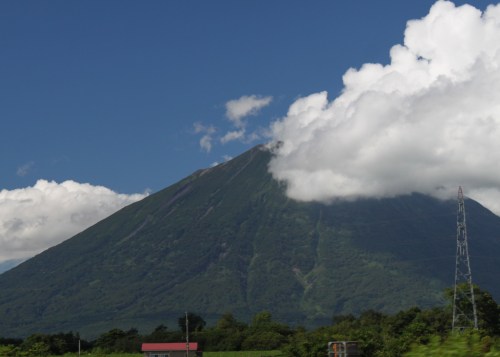July’s Calendar Photo is from Shokanbetsu, so instead of the monthly ‘calendar footage’ post, I bring you this love-overdue report from the archives:
The sleepy coastal town of Mashike sits snugly against the towering peaks of the Shokanbetsu range, a magnet for frigid precipitation during the winter months, and heavy fog during the green season. Along the main street a row of buildings dating from the early Meiji era stand out among the newer, rust-stained concrete of the post-war structures. An old kimono shop sits idle, the old shell transformed into a local history museum. I wander through the empty rooms, admiring the striations in the glasswork of the windows. A few doors down, the volunteers at the local sake factory distribute free samples to a busload of tourists pausing briefly before heading to the flowery hills of Furano. Near the end of the street, just before the deserted train station and bus stop, an aging, weather-tained facade with arched windows and a recessed oak entrance serves as my accommodation for the evening. The proprietor, a young family of transplants from Osaka, take me in as one of their own, offering not only a warm meal and drinks, but practical hiking advice for my ascent of Shokanbetsu planned for the following morning.

“There are three routes up the mountain”, explain my guide, “none of which are particularly easy”. With rain spitting down outside, this is not the news I want to hear. Still, I bite my lip and absorb the knowledge, deciding in the end to go with the shortest route up to the summit: a backbreaking 10km one-way ticket to the summit of what the locals have penned ‘Mashike Fuji’.

Bright and early, Grace meets me outside of the single-roomed structure that doubles as train station and tourist information center. After exchanging pleasantries, we file up the paved switchbacks to the 500 vertical-meter Hashibetsu trailhead. Thick cloud hangs heavy in the air as we unload the gear. The foliage is still dripping wet from the late night squalls that pushed in from the sea. We have one very long, sticky and sloppy hike staring us right in the face, so procrastination would do no good. Better to dive into it and get on with it.

The path is well trodden and easy to follow, but getting lost is the least of our worries. The humidity forces the sweat from our pores, which attracts the mosquitos and horseflies. Swatting is an exercise in futility, and the only way to avoid the persistent buggers is to keep moving. The trail is framed on both sides by head-tall bamboo grass, concealing the forest floor and the creatures that lie in the murk. After several minutes of tramping, we come across our first bear prints that couldn’t have been more than several hours old. Unfortunately it appears that we are tramping along an ursine highway, and Grace’s bear spray does little to calm the nerves. If we are lucky we can catch up with the creature and surprise it from behind, but there would be nowhere to go if we met the mighty brown bear head on.

The mountain, like most other volcanoes in this land, is neatly divided into 10 stagepoints which does little to brighten our spirits. In anticipation of the long approach and summer humidity, I had brought along 4 liters of water, but the clouds cool things off enough to have me rethinking my decision. At stage point number 3 (san go-me), I stow away the extra two liters behind the signpost, and notice a much softer prance in my footfalls. My frowns from the previous hours fade away as I sink into a gradual rhythm and enter my tozan zone. The first 4 kilometers of the hike are almost completely flat, and it isn’t until the 5th stage point that we start to rise out of the flatlands along a deep gully eroded away by the torrential rains that frequent this dormant volcanic massif.

Grace and I break into conversation now and again as she updates me on her hiking schedule. You see, she is embarking on a rather unprecedented mission to knock off every single one of the 200 and 300 famous mountains left in Hokkaido, a hectic schedule that consists of nearly twenty peaks dominated by long, exposed climbs. Her mountain adventures have earned her the moniker The Yamaholic, a fitting name for the forty something dekasegi who grinds out a living in a factory in rural Toyama Prefecture. If her dream becomes realized, she will be the first foreigner to complete the entire Sanbyakumeizan, so getting these remaining peaks checked off the northern island will go a long way towards meeting her goal. I really admire that kind of spirit and determination, as I had abandoned my own quest long ago when the first stages of asthma set in. Still, I do have an intention of knocking off several of the peaks from that list of mighty 300. From the pictures in my guidebook, I’ve always had a longing to climb Shokanbetsu, and being able to do it in the company of the Yamaholic is an added bonus.

After another hour of ascending, we finally rise above the thousand meter mark and towards the edge of the tree line. The clouds are playing a game of hide and seek with the surrounding peaks, but in those brief intervals we can just make out the edge of the wetlands of Uryu to the south. Uryu marsh is one of Hokkaido’s hidden spots of ethereal beauty. In fact, a lot of visitors actually prefer climbing Shokanbetsu from this southernly approach, as the marshlands teem with wildflowers from June to October. There’s only one problem with the Uryu route: it is 23km round-trip to the summit and back, something that even us seasoned veterans can not muster up the stamina for.

At the 7th stage point (nana go-me), the bamboo grass yields to vast gardens of wildflowers of every imaginable shape, color, and size. The Yamaholic breaks into a huge grin, the first of the day after setting out earlier that muggy morning. The terrain morphs to alpine tundra as the views to the south open up. Clouds are moving in swiftly from the sea to the north, however, so our vistas are soon erased by the mist.

10 minutes past the garden we stumble across fresh scat the size of a rugby ball. Luckily the cloud hides the bear from our sights but if there’s one good sign to seeing gargantuan bear excrement it’s that the creature is very well-fed, meaning it is less likely to seek us out for lunch.

Soon we hit a junction where the two routes from the southern approach turn into one for the final push to the high point. The Shokan route is also a popular route and follows a parallel ridge up the spine to the summit plateau. The weather had kept the other hikers at bay though, and shortly after noon the Yamaholic and I stand next to the small shrine and summit marker affixed to the top. We give each other a high five and dig into our rice balls while waiting for the clouds to clear. Dreadfully, the mist refuses to budge, so we stare at the photos in our guidebook and use our imagination to trace the outline of the sea directly below. Drops of rain begin to fall just as we finish repacking the gear, and soon we find ourselves in the midst of one of those notorious Hokkaido squalls that put your rain gear to the test. We fly out of there like mice fleeing a cat kennel and drop back down into the sheltered coves of the treeline just as the rain peters out.

I pick up the two-liter I had stashed earlier that morning and we continue the descent through a fresh layer of ankle-deep mud. Once back in the flatlands the sun makes a late yet welcomed appearance as we brace ourselves for another blood feast. The mosquitos go to town but the spirits remain high after knocking off one of Hokkaido’s toughest day hikes.

The Yamaholic drops me off in Asahikawa as she continues her journey to the next mountain. I, on the other hand, take a well-deserved weekend off by crashing at a friend’s place while preparing for the ferry back to Honshu.












